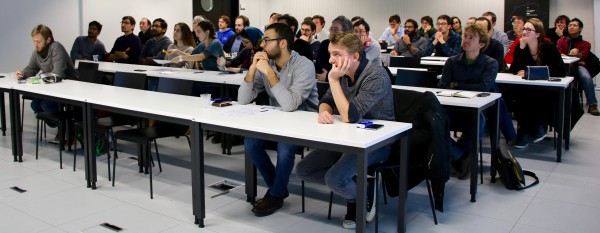MARVEL Junior Seminar — December 2019
The MARVEL Junior Seminars aim to intensify interactions between the MARVEL Junior scientists belonging to different research groups located at EPFL. The EPFL community interested in MARVEL research topics is very welcome to attend. We believe that these events will be central for establishing a vibrant community.
Each seminar consists of two presentations of 25 minutes each, allowing to present on a scientific question in depth, followed by time for discussion. The discussion is facilitated and timed by the chair.
Pizza is served at 11:45 in the MED hall (floor 0), and after the seminar at 13:30 you are cordially invited for coffee and dessert to continue discussion with the speakers.

MARVEL Junior Seminar Organizing Committee — Giuliana Materzanini, Stefano Falletta, Olga Syzgantseva, Maria Fumanal, Markus Stricker, Kristians Cernevics, Max Veit and Patrick Mayor
Abstract — Designing graphene nanoribbon junctions
Kristians Cernevics, Oleg V. Yazyev
Chair of Computational Condensed Matter Physics (C3MP), EPFL
Graphene nanoribbons (GNRs) have recently emerged as promising candidates for next-generation electronic devices, including the realization of all-graphene nanocircuitry. Junctions connecting two or more GNRs are the elementary components of GNR circuits. We systematically address the electronic transport properties of 60°- and 120°-angled junctions connecting a pair of GNR leads of identical width and chirality by means of tight-binding model calculations. An exhaustive exploration of GNR junctions carried out by screening over 50,000 configurations allows us to formulate general guidelines into engineering transport properties of GNR circuits. For instance, we find that 120°-angled junctions with sublattice imbalance have a perfect transmission via a resonant state occurring at zero energy, and thus identified as ideal GNR interconnects. Overall, we present an extensive library of GNR junctions and offer guidelines into engineering transport properties.
Abstract — Computational and Theoretical Chemistry for Metal-Organic Compound Research
Olga A. Syzgantseva
Laboratory of Molecular Simulation (LSMO), EPFL
Hybrid Metal-Organic crystalline materials attract growing attention in various applied fields, including photovoltaics, photosensing, photocatalysis, membrane technologies, etc. Two classes of such materials – hybrid perovskites1-3 and metal-organic frameworks4,5 – are currently at the center of research interest. Despite a significant progress in this field, there still remain phenomena, for which experimental physicochemical methods cannot provide a sufficiently full understanding, and this prevents an adequate qualification of some studied phenomena. Therefore, for the successful development and expansion of metal-organic research, computational modelling on supercomputers is used, that in its turn creates a need for theoretical models, adequate to experimental data. This challenge brings to the forefront the necessity of on-line collaboration between experimentalists, computational chemists and theoreticians, which is intended to ensure a fruitful background for the research on a qualitatively new level. In this talk, some examples1-5 of this kind of interaction between experimentalists, computational chemists and theoreticians will be presented and some preliminary conclusions on the research potential of such interactions will be made.
1. O.A. Syzgantseva, M. Saliba, M. Grätzel, U. Rothlisberger, J. Phys. Chem. Lett. 2017, 8, 1191-1196
2. M.A. Syzgantseva, O.A. Syzgantseva, Theor. Chem. Acc. 2019, 138, 52.
3. A.A. Sutanto, V.I.E. Queloz, I. Garcia-Benito, K. Laasonen, B. Smit, M.K. Nazeeruddin, O.A. Syzgantseva, G. Grancini,APL Materials 2019, 7, 041110.
4. M.A. Syzgantseva, C.P. Ireland, F.M. Ebrahim, B. Smit, O.A. Syzgantseva, J. Am. Chem. Soc. 2019, 141, 6271-6278.
5. M.A. Syzgantseva, N.F. Stepanov, O.A. Syzgantseva, J. Phys. Chem. Lett. 2019, 10, 5041-5046.
Check the list of the next MARVEL Junior Seminars here.
Low-volume newsletters, targeted to the scientific and industrial communities.
Subscribe to our newsletter